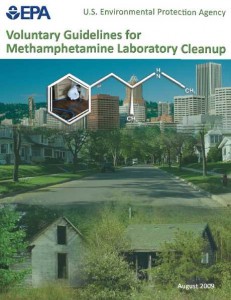EPA Publishes Guidelines for Methamphetamine Lab Cleanup
 Download HERE:
Download HERE:
 FlammablesPPT.ppt (3.6 MiB, 2,370 hits)
FlammablesPPT.ppt (3.6 MiB, 2,370 hits)
The Voluntary Guidelines for Methamphetamine Laboratory Cleanup provide guidance for individuals responsible for methamphetamine (meth) lab cleanup. The Guidelines are based on an extensive review of the best available science and practices and addresses general cleanup activities, identifies best practices for specific items or materials, discusses sampling procedures, and provides additional technical resources.
Guidelines Questions and Answers:
Why is EPA publishing these voluntary guidelines?
The Methamphetamine Remediation Research Act of 2007 required EPA to develop guidelines for remediating former methamphetamine labs. This document provides those guidelines for States and local agencies to improve “our national understanding of identifying the point at which former methamphetamine laboratories become clean enough to inhabit again.” The legislation also required that EPA periodically update the guidelines, as appropriate, to reflect the best available knowledge and research.
Who should use these guidelines?
The guidelines are geared towards state and local government personnel charged with remediating or otherwise addressing former methamphetamine (meth) labs. This document helps disseminate the best available knowledge and research on meth lab remediation and will also prove useful to cleanup contractors and could be a resource for homeowners.
Does this document create new regulations for meth lab cleanup?
EPA prepared this document based on best current practices to provide voluntary cleanup guidelines to state and local governments, cleanup contractors, industrial hygienists, policy makers and others involved in meth lab remediation. It does not set requirements, but rather suggests a way of approaching meth lab remediation. Those using this document should also consult their appropriate municipal, county or state guidance documents, regulations and statutes. This document is not meant to supersede municipal, county or state guidance documents, regulations or statutes (however this document may be useful as they develop and/or review and revise their own guidelines).
